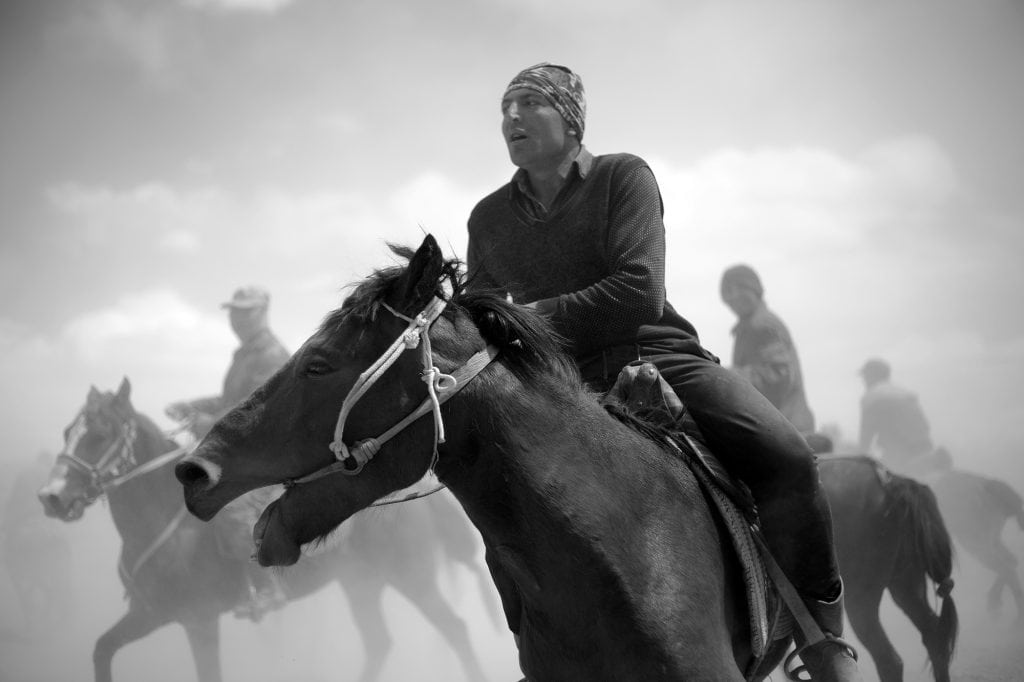A photographic journey through a region whose identity is threatened by “sinicization.”

A man put an embroidered doppa (the traditional cap) on his son. © Maxime Crozet
Maxime Crozet
On the North-Western borders of China lies the immense region of Xinjiang (literally, “New Frontier”). Until a few years ago, the region had a majority of Uyghurs, a Sunni Muslim people speaking a Turkic language, and also included Kazakh, Hui, Kyrgyz, Mongol, Tajik, and other Central Asian minorities. Han Chinese arrived by the millions in the last decades and now amount to 40% of the local population.

An old Uyghur man in a village near Turpan. © Maxime Crozet
The CCP’s strategy, aimed at suffocating any possible hope of autonomy and “sinicizing” this border region, is transforming Xinjiang into a giant laboratory of social control and global surveillance. The ferocious repression of Uyghurs and the totalitarian control of all local populations, is now getting even worse.

An Aksakal (an old and wise man) in his village booth near Turpan. © Maxime Crozet
Traditional urban centers are being destroyed and replaced by Chinese-style buildings, and civilians are involved in the repression under the pretext of security. It is impossible to travel in Xinjiang without perceiving the implacable gaze of the authorities. Even the rare tourists should pass checkpoints, submit themselves to interminable controls, and expect to be repeatedly interrogated. For the Han Chinese, this is China’s Far West, a real “New Frontier” to be reorganized as part of Beijing’s effort to create a “New Silk Road.”

Teams of knights compete in the Buzkashi, the signature sport of the nomadic populations of Central Asia. © Maxime Crozet
During a trip from the Caspian Sea to Kazakhstan and Pakistan in March-June 2018, I crisscrossed for several weeks this vast borderland of China. Looking for the new frontiers along the oases that mark the old Silk Road, beyond the empty and solitary spaces, I filled my memory with barefaced horizons. In the small streets of old Kashgar, or during a match of Buzkashi (a sort of polo played with a dead goat) or a traditional wedding, I let myself flow with the different local cultures, looking for harmony. I wanted to preserve at the borders of the deserts, the steppes, the snow-white mountains of Central Asia, some intimate footprints of people on borrowed time, threatened by the advance of a new Cultural Revolution.

A match of Buzkashi. The equestrian sport is also popular in Afghanistan. © Maxime Crozet

Two women of the Tajik minority snuggle together. © Maxime Crozet

An old man in a village in the Tashkurgan Tajik Autonomous County. © Maxime Crozet

A young girl posing gladly outside her antiquated home. © Maxime Crozet

A bridegroom in a village near Tashkurgan. © Maxime Crozet

Tajik woman in Tashkurgan, at the Chinese border of the Pamir Plateau. © Maxime Crozet

Tajik woman in Tashkurgan, at the Chinese border of the Pamir Plateau. © Maxime Crozet

Uyghur man in the old city of Kashgar. © Maxime Crozet

Uyghur man in the old city of Kashgar. © Maxime Crozet

A knight riding at the border of Pamir. © Maxime Crozet

A horde of knights suddenly appears on the horizon in the Karakorum mountain range. © Maxime Crozet

An Uyghur woman at her home’s door in Kashgar. © Maxime Crozet

A man affectionately carries his daughter, dressed for a family celebration. © Maxime Crozet

A young man in the Tashkurgan Tajik Autonomous County. © Maxime Crozet

A woman plays the daf (traditional Persian frame drum) at a wedding. © Maxime Crozet

Selling apples in Kashgar’s Grand Bazar. © Maxime Crozet
All rights reserved, Maxime Crozet

Maxime Crozet is a traveling photographer. He discovered his passion for photography during his long travels, until photography became his main profession and the primary way to explore the world. Through his photographs, which express the broad scope of his meetings, his nomadic gaze illustrates the anthropological, documentary, and affective diversity of the portraits. Web site: http://maximecrozet.wixsite.com/photography

